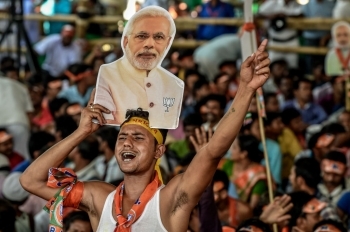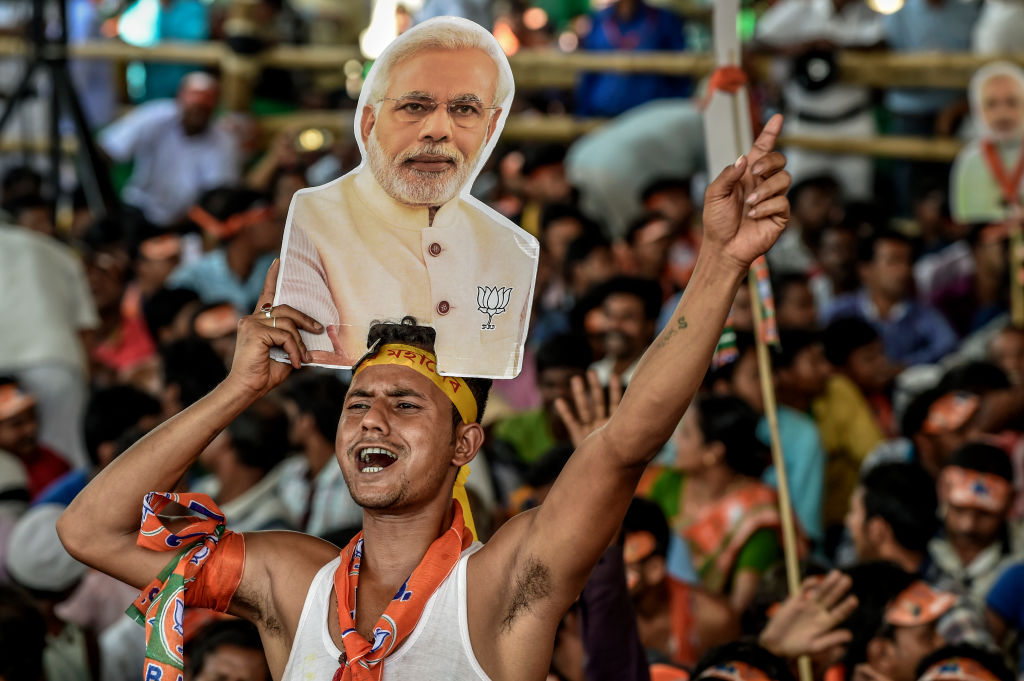
.jpg) Sacaria Joseph
Sacaria Joseph

The consciousness of the binary opposites of ‘us and them’ that forms boundaries between groups of people is the mother of all forms of polarising consciousness including national consciousness.
One might be surprised to know that a polarising national consciousness was instilled in the ancestors of the Judo-Christians by the narrator of the Book of Genesis himself when he says, “These are the sons of Shem by their clans and languages, in their territories and nations. These are the clans of Noah’s sons, according to their lines of descent, within their nations. From these the nations spread out over the earth after the flood” (10:31-32). No wonder a strong sense of nationalism that tends to divide people into ‘us’ and ‘them’ is prevalent all over the world.
Discussing the notion of nationalism, in his book, Nationalism, Steven Grosby says that the Sumerians, the architects of one of the early civilisations of the world between 4100 and 1750 BCE, made a clear distinction between the Sumerians and the non-Sumerians.
Similarly, the Egyptians, whose great civilisation lasted from 3150 BCE to 30 BCE, considered themselves as a people markedly different from those who were not part of their civilisation. Also, a section of the ancient Chinese between the 4th and the 2nd century BCE regarded themselves as superior to the rest of the Chinese population. Even ancient Greek philosophers, Plato and Aristotle, propagated the idea of Hellenes and the barbarians (people from Asia Minor). All these are classical instances of national consciousness that gave rise to the consciousness of the binary opposites of ‘us and them.’
The consciousness of nationalism in India was born during the British colonial period in and through the Independence Movement. The primary goal of Indian nationalism was the attainment of independence for all people inhabiting certain territories of the subcontinent from British rule. Indian nationalism, which was essentially territorial and civic, professed that all inhabitants of these territories seeking independence share a common national identity irrespective of their cultural, religious, linguistic and ethnic differences. The criterion for one’s right to belong to this envisioned independent India where all (regardless of their background) will be treated as equals, was none other than one’s place of birth. The most ardent proponent of this version of nationalism was Mahatma Gandhi, who also happened to be the president of the then Congress Party.
In opposition to the widely accepted territorial and civic nationalism, a group of Hindus of these territories seeking independence from British rule advocated a form of nationalism based on the religion and culture of the majority. This version of nationalism that later came to be called ‘Hindutva’ looked upon the people of the same territories as a majority, ‘us,’ and a minority, ‘them.’ The Rashtriya Swayamsevak Sangh (RSS), a Hindu nationalist organisation founded in 1925, and the Sangh Parivar, an assemblage of Hindu nationalist organisations spawned by the RSS, have always championed the cause of an aggressive Hindutva. The advocates of Hindutva dreamed of an Independent Hindu India where one’s identity as an Indian will be defined by one’s religion and culture, which will unmistakably be the Hindu religion and culture. Hence, all people of other faiths (who are all religious minorities), will have to be in accord with the Hindu religion of the majority and embrace the Hindu culture if they wish to remain Indians.
In his book, Essentials of Hindutva, published in 1923, Vinayak Damodar Savarkar, who provided the ideological foundation for Hindutva, argues that “Forty centuries, if not more, had been at work to mould … [Hindutva] as it is. Prophets and poets, lawyers and lawgivers, heroes and historians, have thought, lived, fought and died just to have it spelled thus.” The three essential aspects of this Hindutva, according to him, are the notions of a common rashtra (nation), a common jati (race) and a common sanskriti (civilization).
Defining his restrictive identity of the Hindu, Savarkar says, a Hindu is a person “to whom Sindhusthan is not only a Pitribhu but also a Punyabhu.” If a person has Sindhusthan as his pitrubhu (fatherland), he is part of a common rashtra and belongs to a common jati. If he has Sindhusthan as his punyabhu, where Sanskrit functions as the language facilitating and representing the common rites and rituals, ceremonies and sacraments, he is part of a common sanskriti.
The concept of Sindhustan is related to the Aryan settlement in the Asian subcontinent that took place somewhere between 1800 and 1500 BCE. The Aryans settled in the Indo-Gangetic plains and in the valley of the Indus River (called ‘Sindhu’ in Sanskrit). Part of this subcontinent that later came to be called Sindhusthan has its northern border along the river Indus and its southern border at the Indian Ocean (referred to as ‘Sindhu’ in Sanskrit). Savarkar argues that “Sindhu in Sanskrit does not only mean the Indus but also the sea which girdles the southern peninsula so that this one word Sindhu points out almost all frontiers of the land at a single stroke and so the epithet Sindhusthan calls up the image of our whole Motherland: the land that is between Sindhu and Sindhu — from the Indus to the sea.”
As the Sanskrit word ‘Sindhu’ gave birth to the word ‘Hindu,’ the people who settled in the valley of River Indus (Sindhu) came to be referred to as Hindus. Savarkar argues that Hindus are not only the inhabitants of the geographical region between the Indus River and the Indus Ocean and the Himalayas but also the descendants of the Aryans. The geographical unity of the land of their settlement helped the Aryan race to develop a sense of unity as a people as well as a sense of national and cultural consciousness.
Even though the Constitution of India affirms that India is a secular state with no state religion, to Savarkar and the adherents of his belligerent Hindutva ideology, to be an Indian is to be a Hindu with religious and cultural significance. He maintains that it is not enough that a person is a legal inhabitant of this land called Hindustan to be considered an Indian who is essentially a Hindu. If a person has to be a Hindu, a real citizen of Hindustan, they have to have Hindustan as their pitrubhu, fatherland (the land of his/her forefathers), and their punyabhu, holy land (the land of the origin of their religion).
Following this idea of Hindutva, people having their origin in other countries, who consider India as their holy land – the Chinese or the Japanese for example – cannot be considered Hindus, because India is not their pitrubhu. On the other hand, despite India being the pitrubhu of the Muslims, Christians, Jews and Parsees born and raised in India, they cannot be considered Hindus because they do not consider this land as their ‘holy land.’ Savarkar’s theory of Hindutva, which is padded by his notion of pitrubhu and punyabhu (fatherland and holy land) strips 20% of Indians of their identity as Indians.
Savarkar considers the followers of Sanatanism, Jainism, Buddhism, Lingaitism, Sikhism, the Arya Samaj, the Brahmo Samaj, the Dev Samaj, the Prarthana Samaj and such other religions of Hindusthani origin, to be Hindus because this land is both their pitrubhu and punyabhu. In Savarkar’s India, people of other faith have no choice but to embrace Hinduism if they want to qualify themselves as Indians. “Any convert of non-Hindu parentage to Hindutva can be a Hindu, if bonafide he or she adopts our land as his or her country and marries a Hindu, thus coming to love our country as a real fatherland, and adopts our culture and thus adores our land as the Punyabhu (sacred land). The children of such a union as that would, other things being equal, be most emphatically Hindus.”
Hindus, according to Savarkar, are not only a nation but a jati (race) that is determined by a common origin, possessing common blood. They not only have in their veins the blood of the mighty race incorporated with and descended from Vedic forefathers but also have inherited the culture of the same race. This culture, he argues, is expressed in and “represented by a common history, a common literature, art and architecture, law and jurisprudence, rites and rituals, ceremonies and sacraments, fairs and festivals.” He is categorical in stating that a Hindu “addresses this land, this Sindhusthan as his Holyland (Punyabhu), as the land of his prophets and seers, of his godmen and gurus, the land of piety and pilgrimage.”
Christians and Muslims of India are not and cannot be part of the nation because of their differences from the Hindus in religious and cultural terms. “Their holy land,” argues Savarkar, “is far off in Arabia and Palestine. Their mythology and Godmen, ideas and heroes are not the children of this soil. Consequently, their names and their outlook smack of foreign origin. Their love is divided.” In Savarkar, therefore, the narrative of nationhood acquires a distinctly religious and cultural dimension that is highly detrimental to the idea of a secular and syncretic India.
The culture of the Hindus, Savarkar argues, is expressed chiefly through their common classical language, Sanskrit, which he thinks is the common reference point for all Indian languages. He wants every political programme of the Hindu nationalists to call for recognition of Sanskrit or Hindi, the vernacular language closest to it, as the national language. Many proponents of Hindutva see ‘Hindiness’ as synonymous with Indianness even though, according to the 2011 census, there are 22 scheduled languages and 99 non-scheduled languages in India, and 96.71% of Indians have one of these 22 scheduled languages as their mother tongue.
In his book, We or Our Nationhood Defined, M.S. Golwalkar, the head of the RSS from 1940 to1973 and who replaced Savarkar as the principal ideologue of Hindu cultural nationalism, writes that “Hindustan is the land of the Hindus and is the terra firma for the Hindu nation alone to flourish upon…” According to him, India, a land of pristine beauty and greatness was desecrated and devastated by foreign invaders, and it needs regeneration as a Hindu nation. Golwalkar is opposed to territorial and civic nationalism which, according to him, are the sole reason for all the ills of India. Therefore, he too advocates a religious and cultural nationalism, on the lines of Savarkar.
When the Bhartiya Janata Party officially adopted Hindutva as its ideology in 1986, it indirectly announced the replacement of India’s territorial and civic nationalism with religious and cultural nationalism as its political agenda. Simultaneously and stealthily, it also introduced the policy of polarisation, the ‘us and them’ division, into the heart of Indian national consciousness for political advantage. Ironically, however, while presiding over a Bharat polarised into the majority ‘us,’ and the minority ‘them,’ the guardians of Hindutva dream of an Akhand Bharat that comprises India, Pakistan and Bangladesh. The more ambitious of them dream of a greater Akhand Bharat that includes even Afghanistan, Myanmar, Sri Lanka and Tibet. As they chant ‘Vasudhaiva Kutumbakum’ (the whole world is one single family) from the Upanishad in a gesture of welcome to the rest of the world, India, long known for embodying the spirit of unity in diversity, stands at a dangerous crossroads where its identity as a peaceful and tolerant nation stands threatened from within.